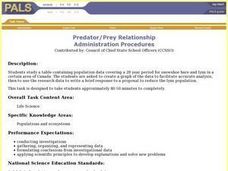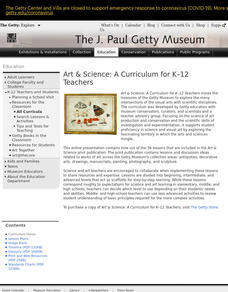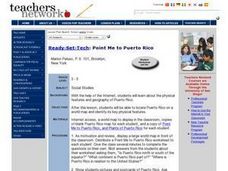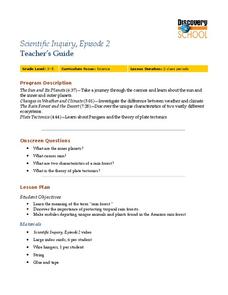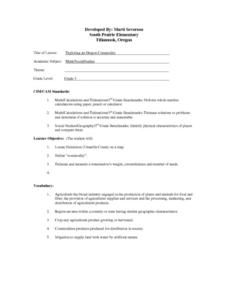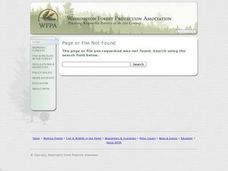Curated OER
Predator/Prey Relationship
Students study and analyze data collected on the relationship between the snowshoe hare and lynx in Canada over a 28 year period and create a graph. Students also write a response to a proposal to reduce the lynx population.
Curated OER
Seasons
First graders investigate the four seasons of the year. In this seasons lesson, 1st graders identify the correct order of seasons, discover different climates, and examine how to dress appropriately for each season.
Curated OER
Exploring Minerals
Students examine the differences between rocks and minerals. They discover the properties of different minerals and perform hardness tests on minerals. They collect their data and make observations.
Curated OER
The Inside of an Apple
Young scholars review the life cycle of apples before they study information about the inside of apples. They work in small groups to color and identify the parts of the inside of an apple. Finally, they use real apples to have an hands...
Curated OER
Podcasting Crusader's Style
Pupils work as a group of scientists studying a specific biome of their choice. In this biome lesson, students research a biome and develop a podcast where factual information is read about a biome and the events of...
Curated OER
Capturing Light: The Science of Photography
Students create their own cameras to understand how artists use light to capture an image in a photograph. In this light lesson plan, students use tape, wax paper, rubber bands, and more to create their cameras.
Curated OER
Footprint Detectives: Making Inferences Using Dinosaur Trackways
Learners analyze and discuss footprints and dinosaur tracks. They listen to books about paleontologists, create and analyze their own trackways using black paper and chalk, examine the data, and form hypotheses about footprints and...
Curated OER
THE FARMER CARES FOR THE LAND
Students will identify cause and effect relationships in issues relating to Agriculture and the environment.Ask students to describe what farmers do. Then ask students to define the word "environmentalist." Ask students if they have...
Curated OER
Point Me to Puerto Rico
Students research the physical features and geography of Puerto Rico as well as locate it on a world map and identify its major characteristics. Pictures and postcards are shown to each class for a visual connection to Puerto Rico as...
Curated OER
Rain Forest
Young scholars study the Amazon tropical rain forest. For this rain forest lesson, students discuss the Manu Biosphere reserve and watch a video about conserving the rain forest. Young scholars create mobiles for the rainforest that...
Curated OER
Transpiration
Students interactively explore the term transpiration. In this science/ecology lesson, students discuss what they would do if they were thirsty while conducting research in Brazil. Additionally, students write descriptive words to...
Curated OER
Observing Brine Shrimp
Students observe brine shrimp eggs, create an appropriate environment for their survival, and observe their growth.
K12 Reader
Food Is Our Fuel
After studying a short article about how living things fuel their growth, readers respond to a series of comprehension questions based on the article.
Curated OER
Germs and Your Body
Students study germs and ways your body fights against disease. In this germs instructional activity students complete an activity that demonstrates where germs can get into your body.
Curated OER
Poisoning the Prairie
Seventh graders investigate what pesticides are and why people use them. They examine the effect of pesticides on prairie grasses and what alternatives can be used.
Curated OER
Exploring and Oregon Commodity
A fun (and delicious!) lesson teaches measurement to your third graders. They work in small groups to first predict, then to measure the weight, circumference, and number of seeds found in a watermelon. Everyone gets to eat watermelon...
Curated OER
Exploring Hawaiian Mountain Zones
Fourth graders watch a video that describes the climate and vegetation zones of Hawaii. They describe the different physical conditions that create vegetation zones from the sea to the mountains. In groups, they create an illustrated...
Curated OER
Science: Fossil of a Carbonized Plant
Students classify leaves by shape and margins and use them to create models of plant fossils. By using paper over a leaf, they simulate fossilization of organisms onto sedimentary rocks. Following instructions on worksheets, students...
Curated OER
Affecting Transportation Choices-Walk, Don't Ride!
Students discuss methods of transportation they use and create a trip tally to determine which methods they use the most.
Curated OER
Oceans in Motion
This simple lesson introduces children to basic marine life as well as to show them the necessity of protecting aquatic environments. Some famous marine life animals are introduced via vocabulary words, then children cut out pictures of...
Curated OER
Fossil Fuels: Facing the Issues
Students explore energy by researching fuel usage on Earth. In this fossil fuel lesson, students define fossil fuels, the energy created by burning them, and the impact on the environment when using them. Students conduct pollution...
Curated OER
The Wonderful World of Slugs
Examine a slug? Of course, what else would a 2nd grader do with it? Pupils use clues and go on a slug hunt, read a slug story, or make a cooperative group mural of a slug's habitat. While older learners catalog slugs, go on a slug hunt,...
Curated OER
Tree Riddle Book
Fourth graders study the tree identification cards, identifying conifers sheet, and western forest cards. From the information gathered from these resources, each team help create a tree riddle book of 12 trees of Washington State.
Curated OER
Transpiration
Young scholars explain the function of the hydrologic cycle and demonstrate how transpiration rates can be experimentally changed.
